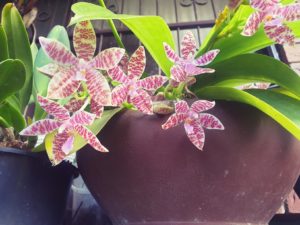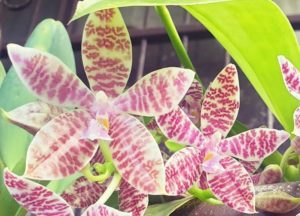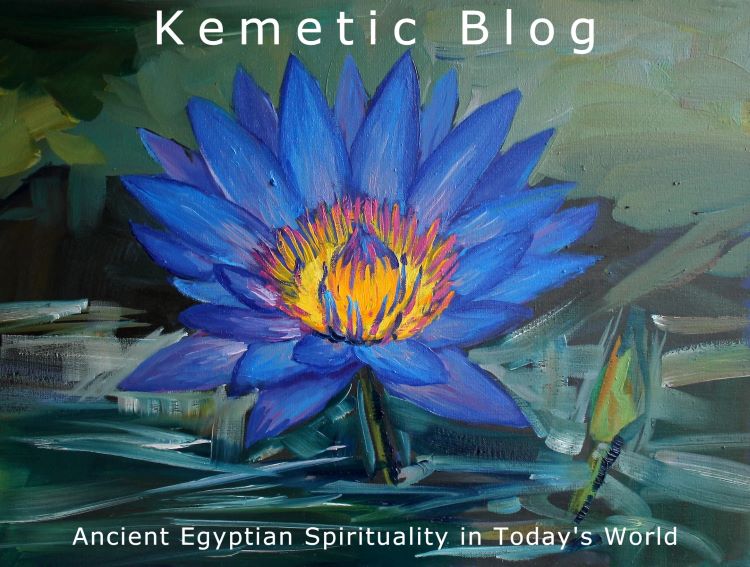
Phalaenopsis hieroglyphica
Orchid. © 2020 Scott Aaron Rose
The Hieroglyphic Phalaenopsis
If Kemetic neo-pagans had to choose just one orchid to represent their religion, they wouldn’t need to look any further than the outstanding orchid species Phalaenopsis hieroglyphica, so named for its fascinating glyph-like markings. Also called the The Hieroglyphic Phalaenopsis, this plant is a sure friend of mystics, spiritual seekers and scribes, which I’ll talk more about later in this post.
We know, of course, that the ancient Egyptians never actually set eyes on this orchid. If they had, we can only speculate whether or not they would have grown it in their own gardens, or if they would have made the same linguistic associations with its markings as botanists in the present day. At any rate, modern Kemetics are living proof that Kemeticism is not confined to the past but growing and blooming in the present.
Native to the Philippines, Phalaenopsis hieroglyphica was first described by German orchidologist, H. G. Reichenbach in 1887 and was originally classified as a subspecies called Phalaenopsis lueddemanniana var. hieroglyphica. It was re-classified as a species in its own right in 1969 by American botanist, Herman Sweet. Although Phalaenopsis hieroglyphica became a protected species in 1975, there were enough specimens in cultivation to make these plants ethically available to garden enthusiasts today. There may also be special circumstances when a permit is granted to take these plants from the wild.
The picture above is one that I’ve taken of my own Phalaenopsis hieroglyphica orchid, which I’ve owned for many years. While the Northern hemisphere is gearing up for Halloween, in the Land Down Under, we are in the throes of spring. That’s when this lovely orchid species covers itself in blooms. Orchid species can be notoriously difficult to grow, as opposed to hybrids, which are much easier but I must say that my own Phalaenopsis hieroglyphica has been relatively easy to grow and flowers very reliably.
I will admit that when this plant was a juvenile, I used to spoil it. In fact, it was only watered with Evian water! It was planted in a large, high-quality, Yixing clay pot from China with New Zealand sphagnum moss and horticultural charcoal for substrate. I was a bit pedantic with my orchids back then. Whether or not that pampering made any difference is hard to say.
As you can see, it’s grown into a nice specimen plant. I should also mention that I live in the subtropics and this plant is kept outdoors in the shade of my back verandah, where it receives a good amount of light. As a baby, I kept this plant indoors in a sunny window where it grew quite happily. If you live in a temperate climate and want to grow this species indoors, try your luck! Just keep it away from frost, give it good light and ensure adequate humidity and air flow. A sunny window and a pebble tray should do the trick. Be sure to avoid direct sun which will burn the leaves.
Phalaenopsis hieroglyphica in divination
From a mystical point of view, I have worked with the flowers of Phalaenopsis hieroglyphica in divination (i.e. reading the glyphs) as well as in meditation. For the divination exercise, I close my eyes, pose a question, then clear my mind. Upon opening my eyes, the first flower I see is the one I will start the divination with. In this respect, it’s a lot like reading tea leaves. The reader allows the glyphs to relay stories and messages through the use of their intuitive faculties. Sometimes the glyphs themselves will relay meaning, or an image may present in the mind’s eye.
Try it yourself. At first, it may not look like anything too discernible. Allow yourself to attune to the plant and ask for guidance. Sometimes, I will ask the plant to “show me.” After a while, your consciousness will start to shift from everyday mode into intuitive mode and a glyph will present itself to you.

Phalaenopsis hieroglyphica
Orchid. © 2020 Scott Aaron Rose
After a divination, I like to meditate next to the plant and allow myself to further connect with its energy. While I’ve never used the plant for magic or heka, I suspect it could be done rather successfully and I may attempt it someday. In all the years I’ve owned my Phalaenopsis hieroglyphica orchid, I’ve never once picked any of its flowers, nor harmed it in any way. I’ve always treated it with respect, as a familiar flora of sorts, just as it deserves. Aside from any metaphysical properties it may have, this plant as any, can teach us about the sacredness of all life. If we remember the ethical code of Ma’at that we as Kemetic practitioners live by, no harm should result in our workings with this precious oracle.
Thank you, for reading Kemetic Blog. I hope you enjoyed learning more about the Phalaenopsis hieroglyphica orchid. Divination may not be everyone’s cup of tea but it was and still is a considerable part of Kemetic spirituality. In the foreseeable future (yikes, there’s another pun) I plan to release an oracle card deck based on Phalaenopsis hieroglyphica called, The Orchid Oracle™ Card Deck. Stay tuned!
𓆸
© Scott Rose / Kemetic Blog – All Rights Reserved.

No Comments